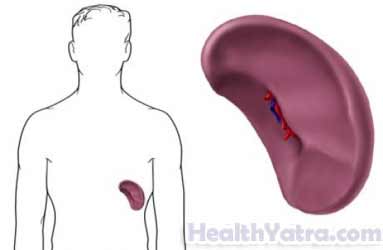Definition
Splenectomy is the surgical removal of the spleen. The spleen is an organ in the upper left part of the abdomen. It is beneath the ribs and behind the stomach. The spleen filters blood to remove bacteria, parasites, and other organisms that can cause infection. It also removes old and damaged blood cells.

Reasons for Procedure
You may need to be treated by having a splenectomy if you have:
- Trauma to the spleen
- Spleen rupture due to tumor, infection, inflammatory condition, or medicines
- Enlargement of the spleen (splenomegaly)
- Certain blood disorders
- Myelofibrosis (abnormal formation of fibrous tissue in the bone marrow)
- Damage in the blood vessels of the spleen
- Leukemia or lymphoma
- Diseased spleen, due to disorders like HIV infection
- Tumor or abscess in the spleen
- Liver disease
Possible Complications
If you are planning to have a splenectomy, your doctor will review a list of possible complications, which may include:
- Infection
- Bleeding
- Hernia formation at incision site
- Blood clots
- Damage to other organs
Factors that may increase the risk of complications include:
- Obesity
- Smoking
- Poor nutrition
- Recent or chronic illness
- Diabetes
- Old age
- Heart or lung disease
- Bleeding or clotting disorders
What to Expect
Prior to Procedure
Your doctor may do the following:
- Physical exam
- Blood and urine tests
- Review of medicines
- X-rays of abdomen—a test that uses radiation to take a picture of structures inside the body
- CT scan—a type of x-ray that uses a computer to make pictures of the inside of the body
- Ultrasound—a test that uses sound waves to visualize the inside of the body
- Electrocardiogram (ECG, EKG)—a test that records the heart’s activity by measuring electrical currents through the heart muscle
- Other tests to evaluate spleen enlargement
- Studies to determine rate of destruction of red blood cells and/or platelets
- Give you vaccines against some infections (Without your spleen, you will be more susceptible to certain infections.)
Talk to your doctor about your medicines. You may be asked to stop taking some medicines up to one week before the procedure, like:
- Aspirin or other anti-inflammatory drugs
- Blood thinners, such as clopidogrel (Plavix) or warfarin (Coumadin)
Anesthesia
General anesthesia will be used. You will be asleep.
Description of Procedure
The spleen can be removed through an open incision or through laparoscopic surgery.
Open Incision
An incision will be made in the abdomen over the spleen. The skin and muscles will be pulled back. The blood vessels to and around the spleen will be tied off. This will free the organ. Moist sponges may be placed in the abdomen. The sponges will absorb some of the blood and fluid. The spleen will be removed. If needed, further surgery may be done at this time to repair other organs. The sponges will then be removed.
The wound will be cleaned. The muscles and skin will be closed with stitches or staples. A gauze dressing will be placed over the wound.
Laparoscopic Removal
A small incision will be made in the abdomen. A laparoscope will be inserted through the incision. The laparoscope is a thin, lighted tube with a small camera on the end. It allows the doctor to see inside your body. Carbon dioxide gas will be passed into the abdomen. This inflates the abdomen and creates more room to work.
Two or three more small incisions will be made in the abdomen. Special tools will be inserted through these incisions. Blood vessels to the spleen will be cut and tied off. The spleen will then be rotated and removed. If the spleen has been ruptured, the abdomen is checked for any other injured organs or blood vessels. If needed, further surgery may be done at this time. The incisions will be closed with stitches and covered with surgical tape.
Immediately After Procedure
The removed spleen is sent to the lab for testing.
You will be taken to a recovery room and monitored. You may require a blood transfusion if you lost a lot of blood in the surgery.
How Long Will It Take?
About 45-60 minutes
Will It Hurt?
Anesthesia prevents pain during the procedure. You may have pain from the incisions for a few days after surgery. If needed, your doctor can prescribe pain medicine to relieve this discomfort.
Average Hospital Stay
The usual length of stay is 2-4 days. Your doctor may choose to keep you longer if complications arise.
Post-procedure Care
It is important to follow your doctor’s instructions for postoperative care:
- Ask your doctor about when it is safe to shower, bathe, or soak in water.
- Replace any wet dressings with clean, dry ones.
- For minor pain, take only medicine that does not have aspirin.
- Avoid vigorous activity (exercise, heavy lifting, etc).
- Avoid driving for about six weeks, or as directed by your doctor.
- Make sure you get all the vaccines that your doctor recommends.
- Be sure to follow your doctor’s instructions.
Recovery time may vary based on the extent of your injuries and any underlying disease or condition. On average, allow about 4-6 weeks for complete healing.
Always let your doctor(s) know that you do not have a spleen. Carry a national splenectomy card, which most hospital hematology departments can give you. When traveling, take special precautions against malaria and other infections.
Call Your Doctor
After you leave the hospital, contact your doctor if any of the following occur:
- Signs of infection, including fever and chills
- Redness, swelling, increasing pain, excessive bleeding, or discharge from the incision site
- Cough, shortness of breath, chest pain, or severe nausea or vomiting
- New, unexplained symptoms
In case of an emergency, call for medical help right away.
